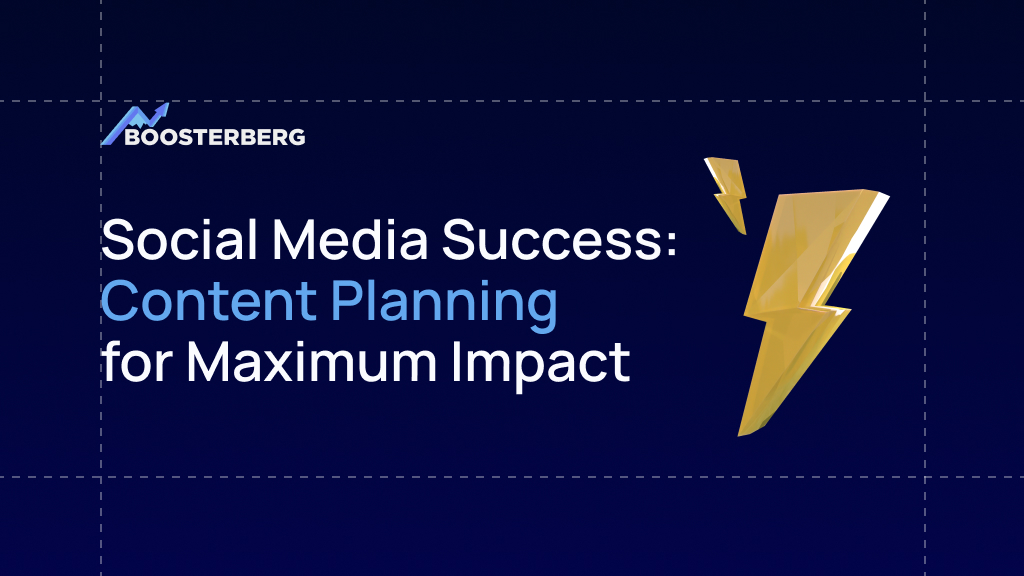Most of us consume social media posts without taking any action, and we post only when we want to. However, brands must plan their social media content. Being prepared is essential to stay on top of followers’ feeds.
It’s important to regularly measure your efforts and optimize your marketing strategy, as we’ve mentioned many times before. And a lack of planning prevents you from analyzing your successes and failures.
Social media planning has quite a few benefits. The first one will be less stress in your life as a marketing manager. If you plan ahead, you will have more time to create high-quality content instead of rushing to post something just because you have to. Posts can be scheduled once you are ready, and you can begin creating more content. This means you can stop worrying about keeping up with all your channels and competitors.
Creating a social media calendar will:
- help you stay organized.
- save you time.
- help you maintain a consistent presence on social media.
- help you measure and analyze your performance.
- stay on top of trends and events.
So let’s have a look at how to create a social media calendar that will work for you.
SOCIAL MEDIA CONTENT CALENDAR
The following is a checklist of things to consider before creating an effective content calendar.
Define your goals.
Regular posting is useless without a goal. In other words, ask yourself what you wish to accomplish on social media. Is your goal to increase brand awareness or drive traffic to your website? Would you like your followers to buy something from you, or do you want them to subscribe to your service? Having a goal in mind will help you take the first step in the right direction.
Who is your target?
Your second question should be – who are you trying to reach? Identify your target persona, including their demographics, interests, and behavior. As different types of people prefer different platforms, you can create multiple personas because not all of them will need to be on the same social media platform. Taking this into consideration leads to the next question.
Pick your social media platforms.
It is not necessary to use every social media channel. Nothing is worse than a brand completely misinterpreting a channel, posting content without trying to adjust it, and expecting success. Putting up content where nobody will read it is a waste of time. Keeping that in mind, select the platforms where your followers are most active. Avoid making it harder than it needs to be by planning for success.
Decide on the types of content you want to post.
Different platforms will require different types of content. Videos don’t work for every brand, so consider your most important points when creating content – if you’re selling a service, it’s difficult to show its benefits through a photograph. Video demonstrations would be much more effective.
You could include videos, reels, stories, educational posts, sales posts, and filler content in your content plan. There are plenty of options to consider and choose from.
There are two standard content marketing strategies you can use to help you determine the right content mix.
The 80-20 rule
- 80 percent of your posts should either educate, entertain or inform your followers
- 20 percent of your posts should be the sales type, e.g., they will be used to promote your brand and convert followers into paying customers.
The rule of thirds
- A third of your content should help you promote your brand and increase conversions
- A third of your content should be curated, e.g., you should re-post content from other thought-leaders in your industry.
- A third of your content should be designed to increase engagement. This content should be entertaining, catchy, funny – anything that will evoke a reaction from your followers.
5. Pick your hashtags
Using hashtags can help you gain more visibility, but too many can drive followers away. Even so, you should keep a list of your favorite hashtags, so you can access them easily.
6. Analyze your results
Posting does not automatically mean that your work is complete. As soon as you begin posting on social media, you will be able to analyze your success and failures and adjust your strategy as needed.
STRUCTURING YOUR SOCIAL MEDIA CALENDAR
Now that you have the basics in order, it’s time to structure them. This article contains a sample social media calendar that you can download, but let’s first talk about what fields you should include.
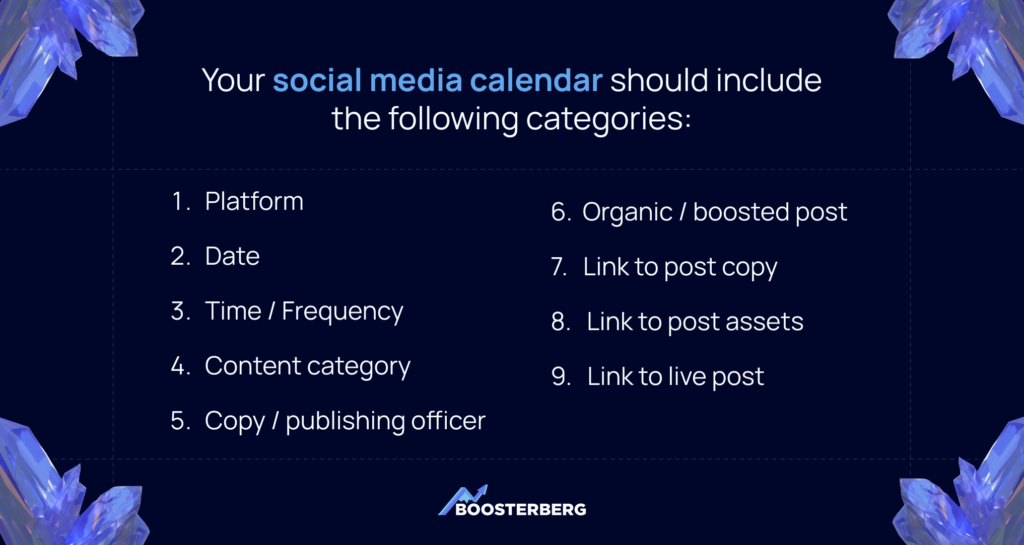
Platform
It can be done in two ways. Each social media platform could have its own calendar or you could track them all together. If you decide to post on multiple platforms, just make sure you don’t post the same content on each platform. Instead, give it some thought and adjust your content accordingly. The same rules that apply to Facebook won’t apply to Instagram.
Date
Your content can be planned a month in advance, or you might find it easier to work with a weekly calendar. No matter which method you choose, using specific dates will let you know what will be live on your social media channels and when. This will help to reduce the stress of trying to be present everywhere all the time.
Time/Frequency
By analyzing your previous posts, you can determine when to post. If you’re new to social media, you can find statistics for each platform. For example, Hootsuite says the best time to post on Instagram is 11 am on Wednesdays.
Don’t take this information for granted because what works for one person might not work for you. Before you get to know your followers and their habits, don’t be afraid to use generally known information as a guide, but don’t rely on it entirely. When you’ve been posting for a while, you’ll have enough data to make an educated decision on when to post.
You will also have to determine what frequency works best for you. Posting every day is the best way to increase brand awareness and reach if you are just starting out.
Content category
Going back to the type of content you want to post, you should have a couple of topics/categories you can post regularly for each platform. For example, on Mondays, you can post educational posts to teach the user how to do something. On Wednesdays, you can post a funny meme or an entertaining video. On Fridays, you can promote your own services.
When you’re just starting out, stick to three to four content types. You should publish them regularly and monitor how they are doing. Some of them might not work at all, so you can experiment with a new type to see if it works.
These are some ideas for what you can include in your content mix based on Boosterberg’s Instagram posts:
Interesting statistics from your industry.
Play around with exciting data that you find, whether it is related to your business or simply your niche. For Boosterberg, it’s marketing.
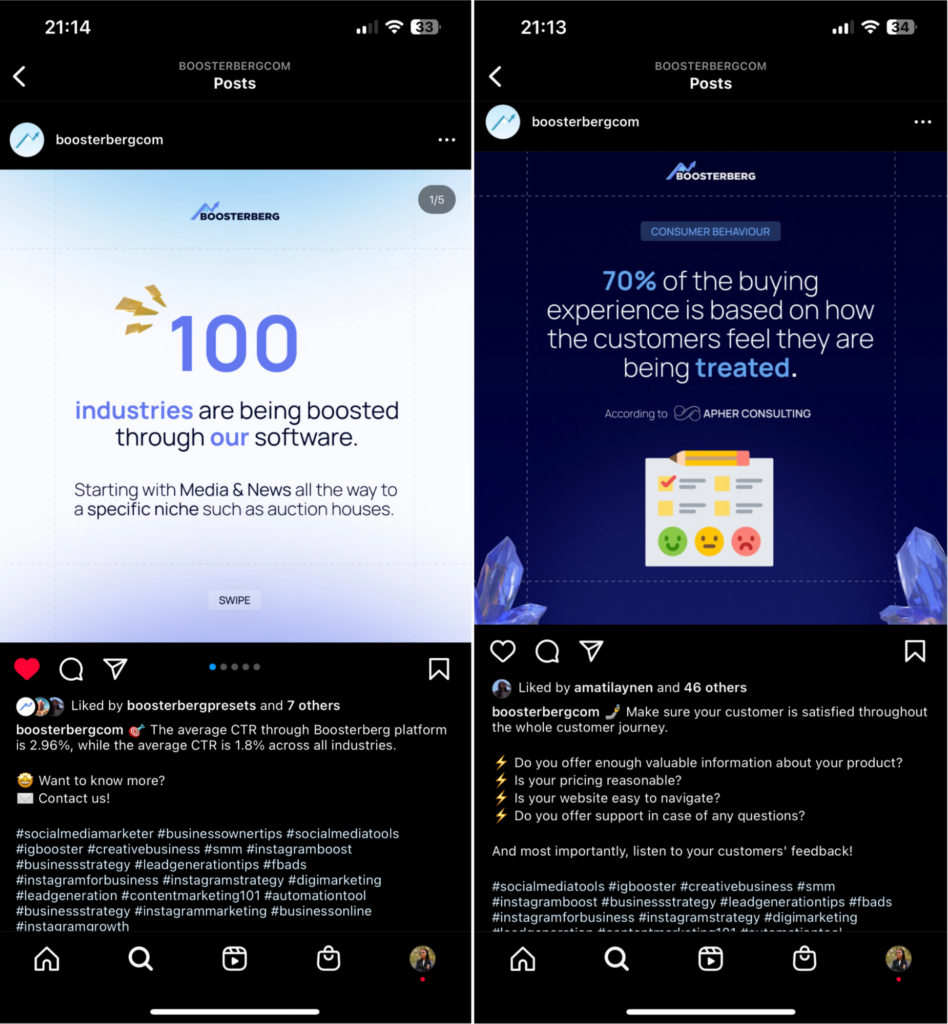
Educational posts are meant to teach the user about a particular subject
Here, you can teach your followers about a specific tool or give them instructions on how to do something. For this type of post, Instagram’s carousel posts are highly effective.
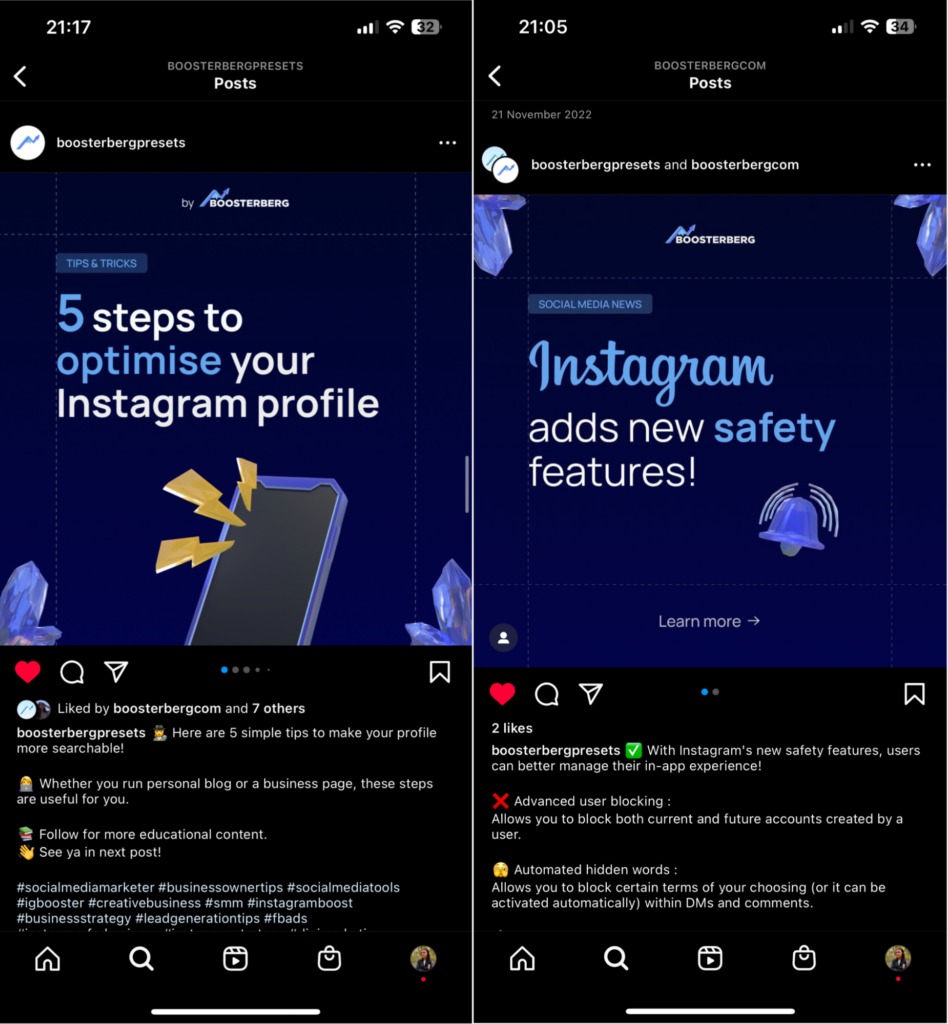
Community posts
Using this method, you can introduce your followers to you, your team, your physical store or office.

Holiday content
You can fill in your social media calendar by planning posts for holidays. You can engage with your followers through creative content whenever something is being celebrated.
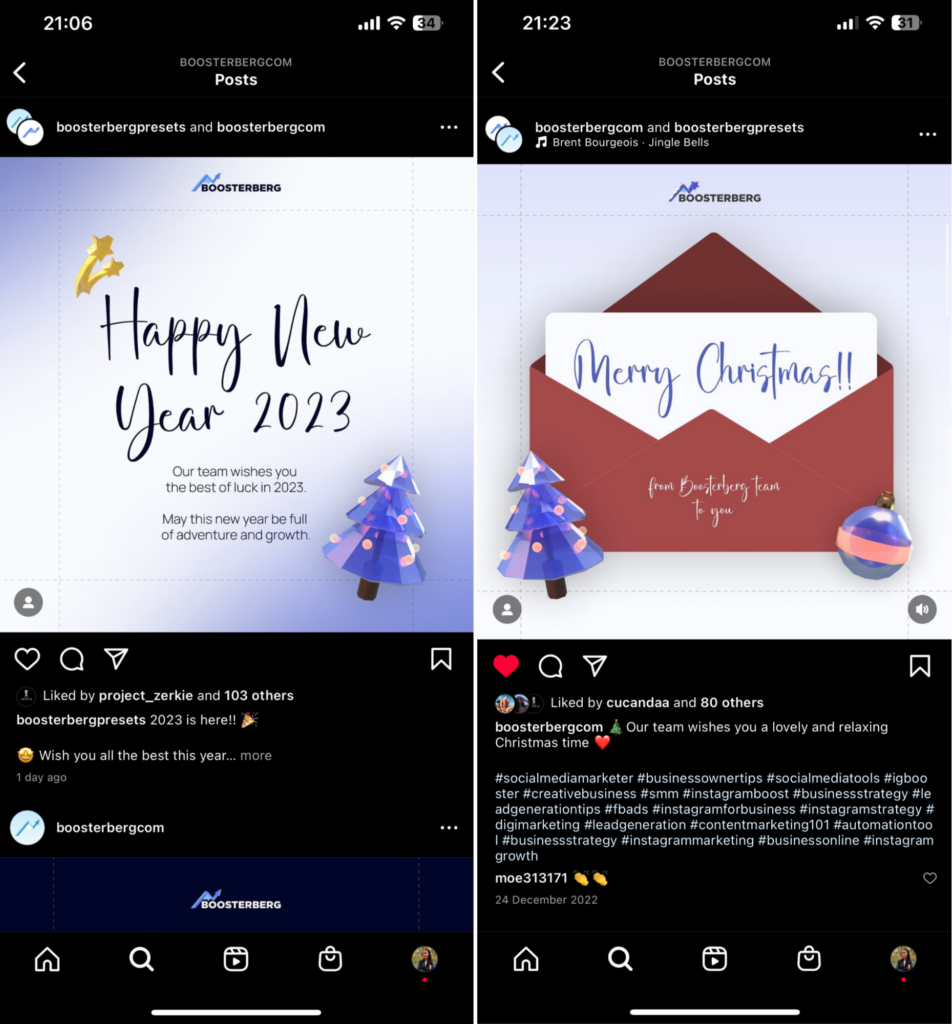
Promotional posts
This is the type of post you’ll create with one specific goal in mind – to convert your followers into customers. Allow yourself to shamelessly promote yourself about 20 percent of the time you post on social media. It’s well deserved after all the other high-quality content you’ve created!

Informational posts
The purpose of these is to let your followers know what’s going on with you, your product, or your service. Instead of selling directly, they’re intended to inform existing customers and perhaps entice new ones.
Additionally, you can curate content and re-post other people’s posts. In the event that you decide to do this, make sure you are using relevant posts, and do not do it too often, as it may scare away your followers.
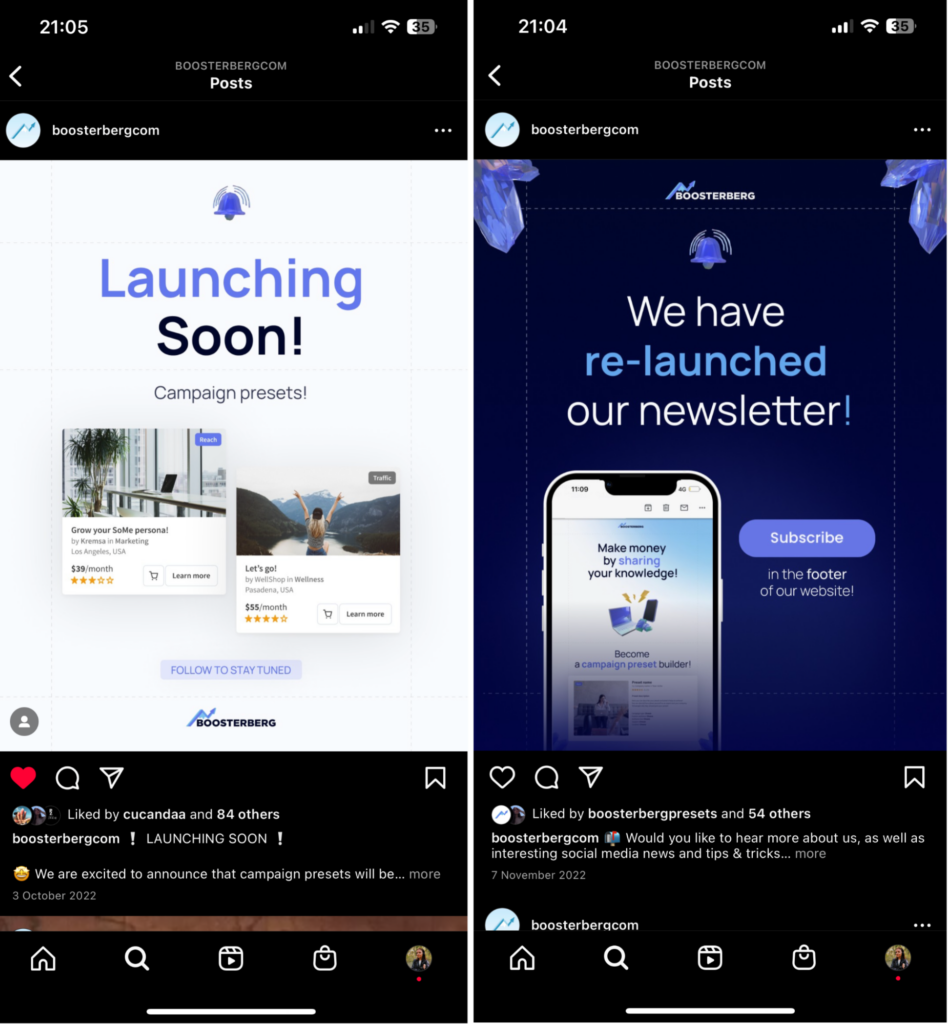
Person responsible for creating the post
Everyone will know what to do, and you can easily keep track of who is responsible for what.
Is it supposed to be an organic post, or do you plan on boosting it
Sometimes you’ll decide based on how well things go organically. Later, you can easily adjust that in the calendar.
Post copy field
You can link to your finished copy, which will be saved somewhere else, such as another Google Doc. By doing so, everyone involved will have access and can see it before publication.
Assets
Here you can link to any assets you want to use – images, videos, etc.
Link to the live post on the social media platform
Post the link to your post to your sheet after you’ve published it. If you do this, you will be able to find your post easily without scrolling through social media feeds.
CREATING YOUR SOCIAL MEDIA CALENDAR
There is a wide range of software available for planning your social media content, which usually comes with a scheduler. To name a few, Monday.com, Hootsuite, SproutSocial, and CoSchedule.
If you’re not a big agency with hundreds of clients, a simple Google Sheet is the easiest way to get started. All you need to do is open your Google Sheets and create a new sheet with all the fields listed above.
Since we already used Boosterberg’s Instagram as an example, we’ll use it again for our social media calendar.
Here’s how it could look.

As you can see, the second you open the sheet you have all your planned content in front of you and most of your questions related to it answered.
If you’re looking for a way to start planning your content on social media, feel free to use our template. You can download it here and adjust it according to your needs.
SUMMARY
There are so many benefits to creating a social media content plan. Planning out posts can help you be more effective, efficient, and organized. When you create your content in batches and schedule posts ahead, you will be able to save time. This will allow you to focus on your targeting, to measure your success, and adjust your strategy as needed. Also, a plan will enable you to remain consistent in your postings, leading to a cohesive brand image. So start today and your future self will thank you.

